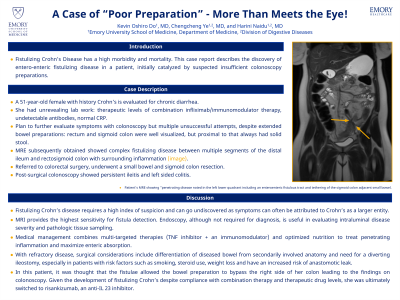Monday Poster Session
Category: IBD
P2253 - A Case of “Poor Preparation” - More Than Meets the Eye!
Monday, October 23, 2023
10:30 AM - 4:15 PM PT
Location: Exhibit Hall

Has Audio

Kevin O. Do, MD
Emory University School of Medicine
Atlanta, GA
Presenting Author(s)
Kevin O. Do, MD1, Chengcheng Ye, MD1, Harini Naidu, MD2
1Emory University School of Medicine, Atlanta, GA; 2Emory Clinic/Emory Healthcare, Atlanta, GA
Introduction: Fistulizing Crohn’s disease has a high morbidity and mortality. This case report describes the discovery of entero-enteric fistulizing disease in a patient with Crohn’s, initially catalyzed by suspected insufficient colonoscopy preparations.
Case Description/Methods: A 51-year-old female with history of Crohn’s presented to establish care. She had been on therapeutic levels of combination infliximab/immunomodulator therapy with undetectable antibodies. Yet, she continued to have chronic diarrhea. Endoscopic evaluation was recommended, but multiple attempts were unsuccessful. The rectum and sigmoid colon were well visualized endoscopically, but proximal to the sigmoid colon was never adequately evaluated due to the presence of solid stool. Despite extended bowel preparations, a significant stool burden persisted on the right side of her colon. MRE subsequently obtained showed complex fistulizing disease between multiple segments of the distal ileum and rectosigmoid colon with surrounding inflammation. It was thought that the fistulae allowed the bowel preparation to bypass the right side of her colon leading to the findings on colonoscopy.
She was referred to colorectal surgery for resection evaluation, ultimately going to the operating room for a small bowel and sigmoid colon resection. A post-surgical colonoscopy was completed, but it showed persistent ileitis and left sided colitis. Thus, the patient was switched to risankizumab for treatment.
Discussion: Diagnosis of fistulizing Crohn's disease is difficult and may go undiscovered as patients may not present with classic symptoms. MRI provides the highest diagnostic sensitivity for fistula detection. Medical management combines multi-faceted therapies and optimized nutrition. With refractory disease, patients are evaluated for surgery. Operative considerations include differentiation of diseased bowel from secondarily involved anatomy and opting for a minimally invasive approach when able. Several randomized controlled trials show that a laparoscopic approach in comparison with open surgery has decreased length of stay and fewer complications with comparable clinical recurrence rates. Another surgical consideration is the need for diverting ileostomy, especially in patients with risk factors such as smoking, steroid use, weight loss and have an increased risk of anastomotic leak with an ileocolectomy.
As shown through this case, fistulizing Crohn’s disease requires a high index of suspicion for early diagnosis and management.
Disclosures:
Kevin O. Do, MD1, Chengcheng Ye, MD1, Harini Naidu, MD2. P2253 - A Case of “Poor Preparation” - More Than Meets the Eye!, ACG 2023 Annual Scientific Meeting Abstracts. Vancouver, BC, Canada: American College of Gastroenterology.
1Emory University School of Medicine, Atlanta, GA; 2Emory Clinic/Emory Healthcare, Atlanta, GA
Introduction: Fistulizing Crohn’s disease has a high morbidity and mortality. This case report describes the discovery of entero-enteric fistulizing disease in a patient with Crohn’s, initially catalyzed by suspected insufficient colonoscopy preparations.
Case Description/Methods: A 51-year-old female with history of Crohn’s presented to establish care. She had been on therapeutic levels of combination infliximab/immunomodulator therapy with undetectable antibodies. Yet, she continued to have chronic diarrhea. Endoscopic evaluation was recommended, but multiple attempts were unsuccessful. The rectum and sigmoid colon were well visualized endoscopically, but proximal to the sigmoid colon was never adequately evaluated due to the presence of solid stool. Despite extended bowel preparations, a significant stool burden persisted on the right side of her colon. MRE subsequently obtained showed complex fistulizing disease between multiple segments of the distal ileum and rectosigmoid colon with surrounding inflammation. It was thought that the fistulae allowed the bowel preparation to bypass the right side of her colon leading to the findings on colonoscopy.
She was referred to colorectal surgery for resection evaluation, ultimately going to the operating room for a small bowel and sigmoid colon resection. A post-surgical colonoscopy was completed, but it showed persistent ileitis and left sided colitis. Thus, the patient was switched to risankizumab for treatment.
Discussion: Diagnosis of fistulizing Crohn's disease is difficult and may go undiscovered as patients may not present with classic symptoms. MRI provides the highest diagnostic sensitivity for fistula detection. Medical management combines multi-faceted therapies and optimized nutrition. With refractory disease, patients are evaluated for surgery. Operative considerations include differentiation of diseased bowel from secondarily involved anatomy and opting for a minimally invasive approach when able. Several randomized controlled trials show that a laparoscopic approach in comparison with open surgery has decreased length of stay and fewer complications with comparable clinical recurrence rates. Another surgical consideration is the need for diverting ileostomy, especially in patients with risk factors such as smoking, steroid use, weight loss and have an increased risk of anastomotic leak with an ileocolectomy.
As shown through this case, fistulizing Crohn’s disease requires a high index of suspicion for early diagnosis and management.
Disclosures:
Kevin Do indicated no relevant financial relationships.
Chengcheng Ye indicated no relevant financial relationships.
Harini Naidu indicated no relevant financial relationships.
Kevin O. Do, MD1, Chengcheng Ye, MD1, Harini Naidu, MD2. P2253 - A Case of “Poor Preparation” - More Than Meets the Eye!, ACG 2023 Annual Scientific Meeting Abstracts. Vancouver, BC, Canada: American College of Gastroenterology.
